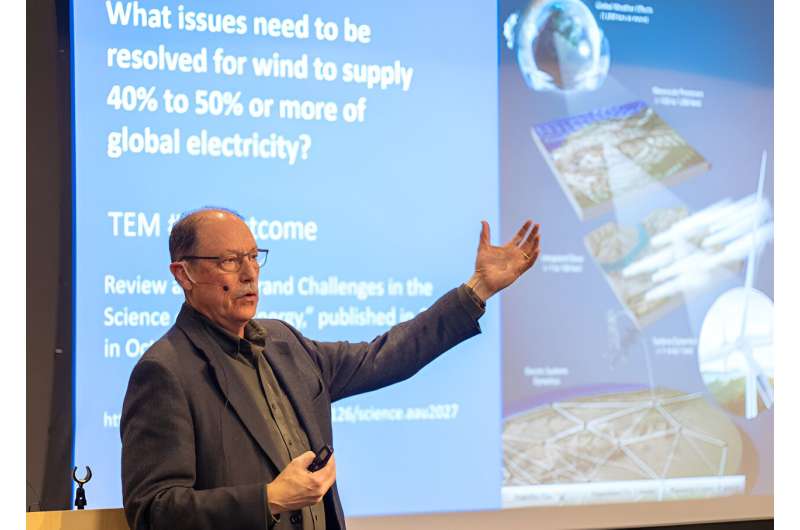This article has been reviewed according to Science X's editorial process and policies. Editors have highlighted the following attributes while ensuring the content's credibility:
fact-checked
peer-reviewed publication
trusted source
proofread
International researchers explore new territory in the grand challenges of wind energy science

Wind energy—one of the fastest-growing and lowest-cost sources of electricity in the world—will play an important role in the transition to a carbon-free energy system. However, wind energy's growth must be planned with careful consideration of atmospheric physics, turbine design, and grid resilience, as well as environmental and social impacts. Finding solutions to these types of challenges will require experts to collaborate across their disciplines.
That is the thesis of a new report co-authored by researchers at the U.S. Department of Energy's National Renewable Energy Laboratory (NREL) along with global industry and academic experts. The report, "Grand Challenges Revisited: Wind Energy Research Needs for a Global Energy Transition," follows a previous report published in the journal Science, which outlined three grand challenges of wind energy research.
Broadly speaking, these original three challenges focused on our inadequate understanding of and inability to accurately model atmospheric physics, wind turbine technology, and wind power plant integration into the grid.
The new report expands those three original challenges to five:
- Wind atmospheric science
- Wind turbine systems
- Wind plants and grid
- Environmental codesign
- Social science.
"Three grand challenges were a grand start," said Paul Veers, an NREL research fellow and report co-author. "But readers of the 2019 Science article pointed out that we had neglected to consider the environmental and social challenges of wind energy development. Recognizing our oversight, we incorporated these additional challenges into our expanded vision."
To further explore these five grand challenges and their intersections, Veers and his colleagues convened an International Energy Agency (IEA) Wind Energy Topical Expert Meeting in February 2023. Grand Challenges Revisited summarizes the key findings from that meeting.
Charting the course for a complex system
Many countries around the world, including the United States, have set ambitious goals to reduce greenhouse gas emissions. A first step toward these goals will be to transition to renewable sources of energy, like wind, in the next few decades.
However, for wind energy to assume its role in the clean energy transition, the industry must address critical issues around the design, development, and deployment of wind turbines and power plants. In addition, as wind energy deployment increases, so will its environmental and social impacts.
"Wind energy is complicated," Veers said. "It comes with technical, environmental, and social challenges that intersect and cut across discipline boundaries."
To help address wind energy's dynamic opportunities for expansion to meet global energy demand, IEA meeting participants examined the cross-disciplinary issues created by the intersections between the five grand challenges. For Veers and his colleagues, these issues highlight a need to integrate social, environmental, economic, and technical elements into wind turbine and plant design before they are built.
"For example, a prospective wind farm site may also be near an eagle population, and wind turbines pose a risk to eagles," Veers explained. "That means the wind turbines and farm need to be designed in a way that minimizes that risk while still maintaining optimal power generation—and that means you need to integrate knowledge about eagle behavior with knowledge about plant optimization."
Common needs across all grand challenges
Through their discussions, all groups at the IEA meeting observed three issues that all five challenges have in common, which are:
- A lack of understanding of basic concepts and terminology between wind energy disciplines, creating a need for cross-disciplinary education
- The challenge of aggregating and managing vast datasets while safeguarding intellectual property, which presents yet-to-be-realized opportunities to leverage existing data through digitization
- That opportunities for discussion, like the IEA Topical Expert Meeting, are rare and sparsely located but are highly enlightening.
"It turned out these experts enjoyed talking to each other across the boundaries of their disciplines," Veers said. "There aren't many places where these different experts can come together, so doing that intentionally should be a goal."
The turbine's continued evolution
The IEA meeting discussions also served as a reminder that wind energy still has lots of room for innovation.
For Veers and his colleagues, supporting the continued advancement of the wind turbine will require a holistic approach to design that considers metrics beyond levelized cost of energy (the ratio of costs expended to energy produced). Those designs need to incorporate intelligent control systems, which enhance turbine awareness and operational efficiency.
Researchers need to step back and think about how these turbines are made, which will help improve industrial-scale turbine production, enhance recyclability, avoid the use of critical materials, and reduce manufacturing costs.
"The current success of the wind turbine does not mean it's a done technology any more than the success of the Model T meant the car was a done technology in 1920," Veers said. "Current wind turbines work and are cost-effective, but the demands of the future will be very different from what they are today and from what they have been in the past. The evolution of the wind turbine is still a major area of opportunity."
Next steps
Now that the participants at the IEA Wind meetings have identified the critical issues at the intersections of wind energy's grand challenges, the next step will be to develop solutions necessary for the substantial expansion of wind energy.
Veers and his co-authors' findings offer the basis for a five-year roadmap for international collaborative research, which will help enable wind energy to fulfill its role in the clean energy transition.


















